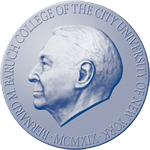Baruch College

Seal of Baruch College
|
|
| Type | Public |
|---|---|
| Established | 1968 as an independent college |
| Endowment | $180.69 million |
| President | Mitchel Wallerstein |
| Provost | David Christy |
|
Academic staff
|
500 (full time) |
|
Administrative staff
|
699 |
| Undergraduates | 13,777 |
| Postgraduates | 3,240 |
| Location |
New York City (Gramercy Park, Manhattan), United States 40°44′25″N 73°59′00″W / 40.740159°N 73.98338°WCoordinates: 40°44′25″N 73°59′00″W / 40.740159°N 73.98338°W |
| Campus | Urban |
| Colors | Blue and White |
| Nickname | The Bearcats |
| Mascot | Bearcat |
| Affiliations | City University of New York |
| Website | www |
 |
|
The Bernard M. Baruch College of the City University of New York, commonly known as Baruch College, is a constituent college of the City University of New York system located in the Gramercy Park section of Manhattan, New York City. Named for financier and statesman Bernard M. Baruch, the college operates undergraduate, masters, and Ph.D. programs through its Zicklin School of Business, as well as the Weissman School of Arts and Sciences and the Marxe School of Public and International Affairs.
Baruch is one of CUNY's senior colleges. It traces its roots back to the 1847 founding of the Free Academy, the first institution of free public higher education in the United States. The New York State Literature Fund was created to serve students who could not afford to enroll in New York City’s private colleges. The Fund led to the creation of the Committee of the Board of Education of the City of New York, led by Townsend Harris, J.S. Bosworth, and John L. Mason, which brought about the establishment of what would become the Free Academy, on Lexington Avenue in Manhattan.
The Free Academy became the College of the City of New York, now The City College of New York (CCNY). In 1919, what would become Baruch College was established as City College School of Business and Civic Administration. On December 15, 1928, the cornerstone was laid on the new building which would house the newly founded school. At this point, the school did not admit women. At the time it opened it was considered the biggest such school for the teaching of business education in the United States.
By the 1930s, women were allowed into the School of Business. The total enrollment at CCNY reached an all-time high of 40,000 students in 1935, and the School of Business had an enrollment of more than 1,700 students in the day session alone. In 1953, it was renamed the Baruch School of Business in honor of Bernard Baruch, an 1889 graduate of CCNY who went on to become a prominent financier and adviser to two presidents. In 1961, the New York State Education Law established the City University of New York (CUNY) system. In 1968, the Baruch School of Business was spun off as Baruch College, an independent senior college in the City University system.
...
Wikipedia
